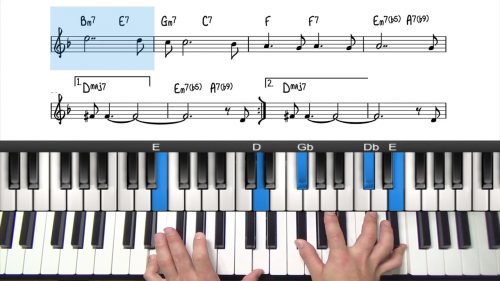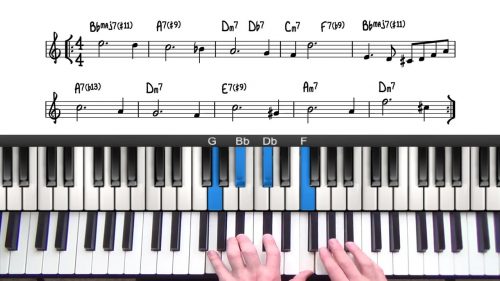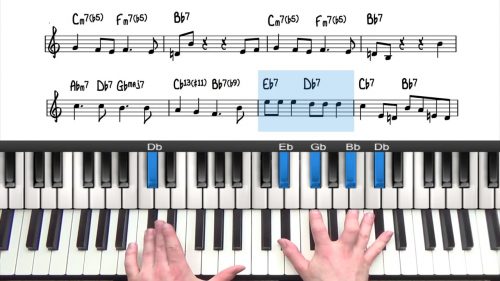Improvising With The Altered Mode
The altered mode can also be referred to as the diminished-whole-tone scale and the super-locrian scale. Be aware that these names are interchangeable. However, these two terms are less frequently used.
The altered scale is an excellent way to gain access to all of altered tensions of a dominant chord. In fact, the altered scale contains every possible altered chord tone which is the b9, #9, #11 and #5 (or b13) — remember that the #5/b13 is the same note, but jazz musicians use both names which can be confusing.
With all of these alterations, it’s no surprise that the altered mode is a tough one to visualise and memorise in all 12 keys.
Download the lesson notation in the Pro Member Area.
How To Construct The Altered Jazz Scale
If we look at the notation of the G Altered mode we can see that every note has been flattened and that the scale contains a b3, b5 and b7.
The presence of the b3, b5 and b7 suggests that the scale should be played over -7b5 chords.
However, if we look a little closer, we can see that the b4 or b11 is enharmonically equivalent to the major 3^rd^.
From a functional standpoint, the altered mode contains a major 3rd and b7th and the b3 can be viewed as the enharmonic equivalent to the #9.
So now we have a very tense sounding dominant scale containing the b9, #9, #11 and #5.
When Can We Play The Altered Mode?
There are a number of chord symbols that imply the altered mode. Again using the key of G as an example, here are the most common ones:
G7alt – G7#9 – G7b9 — G7b13
How to learn and memorise the altered mode?
Well there’s a couple of different approaches here. I personally favour one of the approaches far more than the other but I will explain and demonstrate each for you.
Many people will say that a quick an easy way to find the altered mode is to play the melodic minor scale a half step above. And that’s correct, it is a quick and easy way.
For example, if I wanted to find the G altered mode, I would simply play the melodic minor scale a half step above. A half step up is Ab and so I would play the Ab melodic minor scale.
The main problem with this approach is that you are thinking in terms of another key or another scale. So when you see a G7alt chord on a lead sheet, you first have to think ‘right that’s melodic minor a half step up’. Then instead of analysing the notes in terms of G7, you brain will be thinking about Ab Melodic minor.
In my opinion, this creates an unnecessary step and there is a more effective and functional way to visualise and memorise this important mode.
The alternative is to learn and memorise the scale starting from the root note. This can be done by using the following formula:
R- b9 – #9 — 3 – #11 – #5 — b7 and back to Root.
This is important because then you will be able to visualise the primary chord tones which are Root — 3 — 5 & 7 and also be able to visualise the specific alterations.
The importance of this will become clearer in the next section when we talk about resolving tensions created by the altered mode.
First let’s just run through a few other keys using this approach so that you are clear on how to do this with all 12 keys.
How To Improvise With The Altered Scale
So now that we have a good understanding of the construction of the altered mode. Let’s explore how we can resolve the altered tensions in the scale.
This is perhaps the most valuable piece of information to take away from this lesson.
If we think back to the 251 progression, we know that the 7th of the chord always resolves down a half step to become the 3rd of the next chord. You can use this resolution in your lines to outline the chord change that is taking place, let’s look at a few examples.
In the same way that the 7th wants to resolve to 3^rd^ in a 251, the alterations of the altered mode have strong resolution points that you can utilise in your improvised lines.
Remember that one of the hallmarks off jazz is the creation of tension and then resolution of tension and so having an understanding of how to resolve alterations is very important.
To demonstrate this let’s use a 5-1 progression in C- which is G7alt to the 1 chord C-
Here’s the G Altered mode, working from the bottom upwards, the first alteration is the b9.
Lesson Downloads
-
Melodic Minor Modes Cheat Sheet File Type: pdf
-
Melodic Minor Modes – All 12 Keys File Type: pdf
Practice Tips
In the lesson I demonstrate how I practice improv with the iReal Pro app.
-
First of all download the 251 practice exercises. You can do get these by searching '251 practice exercises' in the iRealPro forums.
-
Next load up a minor 251 practice chart and highlight the 251 in C Minor. Once highlighted you have set this loop and you can increase the number of repeats.
-
Go into the 'Mixer' option and change the Drums option to 'click on 2&4'. In jazz, beats 2 & 4 are heavily emphasised in contrast to beats 1 & 3 in classical music. Putting an emphases on beats 2 and 4 helps drive the music forward and practicing with this beat helps you develop a stronger sense of time.
-
When playing over a single progression like this, make sure you are really explore the notes of the altered mode and also paying attention to where you are resolving to on the 1 chord.
- Some of your ideas will sound better than others and just roll with this... it's all part of the process of discovery. Also make sure you are practicing this in different keys.








Great lesson. Love your program. I took classical lessons from age 6-16. Stopped playing for 30 years and I’m back playing daily. Thank you
Thanks Michael…. glad you enjoyed the lesson. Daily practice is the key to improving so keep it up :-) Cheers, Hayden
Can you give me a plan for daily exercises. I tend to work on learning new songs vs practicing technique. What would you suggest for 15-30 minute warmup
Michael A Sclafani M.D.
Hi Michael, check out this lesson on creating an effective practice routine: pianogroove.com/exclusive-practice-tips/
The main point is to split up your practice time so that you are not spending hours on end doing the same thing. This way you can cover lots of different topics in one sitting. It’s also vitally important to revisit what you have practiced so that you can see the improvement which is a big moral boost!
Chose a selection of things to practice, this could be:
– major/minor scales
– major/minor modes
– major/minor 251s
– major/minor 251s with a lick or line over the top
– upper structure triads (USTs)
– USTs in a 251 progression
– Improv practice exercises like the 251 exercise in this lesson
– Finally playing your favourite jazz standards
Remember to just spend 5/10 minutes on these each day so that in 15/30 minutes you can cover 3-6 of these areas.
It’s important to practice both the theory and jazz standards. Always try to apply the theory to the tunes you are playing.
Hope this helps :-)
Hayden
Thank you so much. I have really gotten in to your course and this seals the deal.
Hey Hayden. I have a question about the part of this lesson where you taught us how to make 7th chords starting on each degree of the altered scale of G. I’m wondering why you use B flat instead of B natural because isn’t that the third of the G7 altered scale? Also, if the scale sharps the 5th why did you flat the D instead of using E flat? Thanks!
Hi Josh,
Yes the altered mode contains the root, b2, b3, b4, b5, b6 and b7.
From looking at these tones, one would assume that this scale is associated with -7b5 chords, because we have the b3, the b5 and the b7.
However, the b4 is enharmonically equivalent to the major 3rd (ie. it is the same note). Also the b3 is enharmonically equivalent to the #9.
If we analyse these notes in that way, we now have a dominant chord scale containing the major 3 and b7 (essential chord tones of a dominant chord) and also the b9, #9(b3), the #11(b5), and #5(b6) – this gives you all possible alterations over a V chord so we have an extremely colourful dominant chord scale.
It’s useful to analyse the scale as – root, b2, b3, b4, b5, b6 and b7 – because this makes it easier to visualise and construct from the major scale, simply flatten every note. However, you need to understand the the b4 is functioning as the major 3rd and then you should be able to visualise the other notes as the alterations of the dominant chord.
I hope this helps Josh… it can be tricky to understand at first. If you’d like further explanation, let me know.
Cheers,
Hayden
Hi Hayden, it seems to me that we can translate in our minds this minor 251 progression (whereby 2 is harmonised as flat 5 chord), as a progression of 3 other minor chords: 4m7 / #5m7 / 1m7 (we can also play all of them as minor-major 7 chords), whereby in improvisation we simply play bebop scale, on each chord, meaning that in improvisation we can play both 7 and major 7 whatever fits better a phrase. For me this was very easy way of memorising it and finding right chords and scales at any time in any key. Easier then thinking about three different types of scales for these three chords…Of course, the bas plays normal 2-5-1…
Hi Simke,
Yes that’s an interesting way of looking at minor harmony. We have a new teacher coming onboard soon and his first course is on his personal view of harmony and improvisation.
His approach sounds similar to your analysis, and so I think you will enjoy his teachings.
I will have more to announce soon :-)
Cheers,
Hayden
Excellent lesson. Top class teaching. Thank you. I’ve always thought of the altered scale as minor/major halves from half a step up and you’re right – it is needlessly complicating an already complicated process. I can change!
Where on this site are the instructions for accessing and using the IRealPro program?
Hi Carl,
You can find the instructions here in the community area: community.pianogroove.com/t/irealpro-backing-tracks-setup/651/10
You will see the links to download the song packs in that thread.
If you have any questions you can reply there and I will be happy to assist you further with the setup.
Cheers,
Hayden
A difficult but great lesson. Can I play an altered mode in both minor and major 251 progressions.
Hi Cornelius, yes that’s right we can play the altered mode over 251s in major and minor keys. Check out the new “Cocktail Piano Improvisation Course” where we apply chord alterations and altered arpeggios to the tune Misty – pianogroove.com/jazz-piano-lessons/cocktail-improvisation-for-beginners/ – Cheers, Hayden
Thanks for this lesson,
I wonder what material to play over the II Chord in the minor II-V-I. It seemed that you played lots of chromaticism in your improv and you played the natural 9 of Dmb57 (which is E), where one could think that the following chords would suggest E flat…
Greatings and thanks!
Hi Swen 👋
Great question.
Yes you are correct that both the natural 9th and the b9 work over the ii-7b5 chord.
For material to play over the ii-7b5 chord – the chord tones are important (R-3-b5-7), and it’s the b5 which creates the distinction between a regular ii-7 chord and the ii-7b5 chord, and so that note can be an interesting colour to accentuate.
Of course the voice leading is also important that we have in all 251s – both major and minor 251s – where the 7th falls to the 3rd, in this case the “C” in D-7b5 falling a half step down to “B” in the G7 chord.
Here’s a nice arpeggio to visualise over ii-7b5 chords:
If we build a major 7th chord off the b5 of the ii-7b5 chord, this gives us some interesting colours. Over the D-7b5, this would be the notes of Abmaj7 which from bottom to top gives us b5-7-b9-11 of D-7b5. The 11th in particular is a very colourful tone.
If we turn that Abmaj7 into a Abmaj7#5, it then gives us the natural 9th that you mention. That’s a very colourful arpeggio to play over the ii-7b5 chord because it contains both the natural 9 and the 11. Something to experiment with.
We are shortly adding minor 251s to the “Licks & Lines Library” – pianogroove.com/licks-lines/ – they will be around the end of this month.
Talk soon,
Hayden